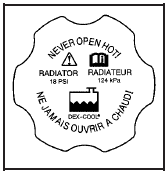How to Add Coolant to the Radiator
WARNING:
An electric engine cooling fan under the hood can
start up even when the engine is not running and
can cause injury. Keep hands, clothing, and tools
away from any underhood electric fan.
WARNING:
Steam and scalding liquids from a hot cooling
system can blow out and burn you badly. They are
under pressure, and if you turn the surge tank
pressure cap — even a little — they can come out
at high speed. Never turn the cap when the
cooling system, including the surge tank pressure
cap, is hot. Wait for the cooling system and surge
tank pressure cap to cool if you ever have to turn
the pressure cap.
If coolant is needed, add the proper mixture directly to the radiator, but be sure the cooling system is cool before this is done.

1. You can remove the pressure cap when the cooling system, including the pressure cap and upper radiator hose is no longer hot. Turn the pressure cap slowly counterclockwise.
2. If you hear a hiss, wait for that to stop. A hiss means that there is still some pressure left.
Keep turning the pressure cap and remove it.
3. Fill the cooling system with the proper DEX-COOL coolant mixture, up to the base of the filler neck.
See Engine Coolant (4.6L Engine) or Engine Coolant (3.9L Engine).
4. Then fill the coolant recovery tank to the COLD FILL line.
5. Install the coolant recovery tank cap and the pressure cap. After a day or two of driving, when the engine is cold, check the coolant level in the recovery tank. If it is low, refill it to the COLD FILL line.
If the coolant in the recovery tank is constantly low, you should have a dealer/retailer service department inspect the vehicle for leaks.
Notice: If the pressure cap is not tightly installed, coolant loss and possible engine damage may occur. Be sure the cap is properly and tightly secured.
See also:
Front Fog Lamp Light
For vehicles with fog lamps, this light comes on when the fog lamps are in use.
The light goes out when the fog lamps are turned off. See Fog Lamps for more information. ...
Adjustable Safety Belt Comfort Guide
On vehicles with the adjustable comfort guide, one guide is provided. Additional adjustable comfort guides are available through your dealer
To install the adjustable safety belt comfort guide to t ...
Passenger Safety Belt Reminder Light
When the vehicle is started, this light flashes and a chime may come on to remind
front passengers to fasten their safety belt. Then the light stays on solid until
the belt is buckled.
For more ...


